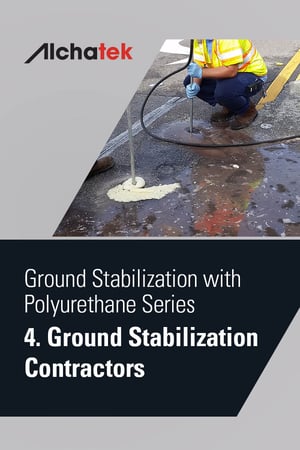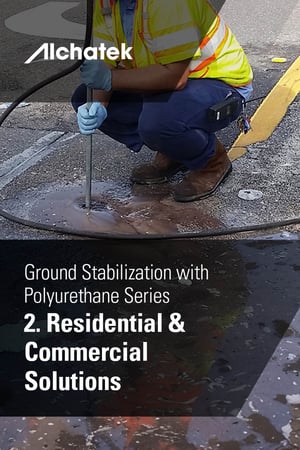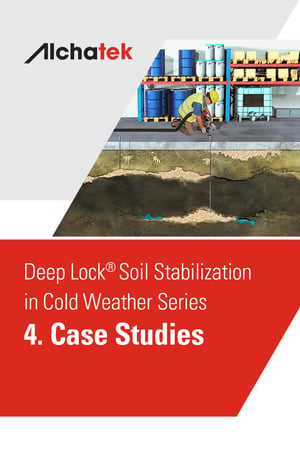
 Choosing the right contractor for ground stabilization using polyurethane is a critical decision that directly impacts the success and longevity of your project. This guide provides essential tips to help you select the most qualified professional for your needs.
Choosing the right contractor for ground stabilization using polyurethane is a critical decision that directly impacts the success and longevity of your project. This guide provides essential tips to help you select the most qualified professional for your needs.
Choosing a Contractor: Key Considerations
- Expertise and Experience: Ensure the contractor has a strong background in ground stabilization, particularly with polyurethane applications. Look for a proven track record.
- Quality of Materials: The quality of polyurethane foam used is pivotal. Confirm that the contractor uses high-grade materials for effective and durable stabilization.
- Client Testimonials and References: Prior client feedback is invaluable. Request references or seek out reviews to gauge the contractor’s reliability and work quality.
- Detailed Estimates: Obtain detailed quotes and timelines. Look for a comprehensive repair plan with clear costs and timelines.
A Professional Partner
Choosing the right contractor is not just about finding someone with the right tools and skills; it's about partnering with a professional who understands your project's specific needs and can deliver results that stand the test of time. Make your decision with careful consideration to ensure a successful and satisfactory ground stabilization process.



 Ground stabilization extends beyond soil to include rock and gravel, crucial for various construction and infrastructure projects. Polyurethane foam, with its expansive and adhesive properties, is an extremely effective solution in these challenging environments.
Ground stabilization extends beyond soil to include rock and gravel, crucial for various construction and infrastructure projects. Polyurethane foam, with its expansive and adhesive properties, is an extremely effective solution in these challenging environments.
 Polyurethane ground stabilization is a proven solution that has been successfully applied in countless real-world scenarios. From fixing residential driveways to supporting the foundations of commercial and municipal buildings, polyurethane foam offers a versatile and dependable approach to ground stabilization.
Polyurethane ground stabilization is a proven solution that has been successfully applied in countless real-world scenarios. From fixing residential driveways to supporting the foundations of commercial and municipal buildings, polyurethane foam offers a versatile and dependable approach to ground stabilization.
 In the world of construction and infrastructure development, the quest for stability is paramount. Whether you're a property owner, manager, or builder, ensuring that the ground beneath your structures is solid and dependable is crucial.
In the world of construction and infrastructure development, the quest for stability is paramount. Whether you're a property owner, manager, or builder, ensuring that the ground beneath your structures is solid and dependable is crucial. 
 If you're a contractor grappling with deep soil stabilization challenges or looking to expand service offerings, Alchatek offers comprehensive support and training to elevate skills and expand business opportunities. Here's how the Alchatek team can assist you in enhancing your Deep Lock® soil stabilization capabilities:
If you're a contractor grappling with deep soil stabilization challenges or looking to expand service offerings, Alchatek offers comprehensive support and training to elevate skills and expand business opportunities. Here's how the Alchatek team can assist you in enhancing your Deep Lock® soil stabilization capabilities:

 This post features three case studies that highlight the versatility and effectiveness of the Deep Lock® process across a variety of applications.
This post features three case studies that highlight the versatility and effectiveness of the Deep Lock® process across a variety of applications.
 In the world of soil stabilization and concrete leveling, the choice of materials is as important as the technique used. Alchatek's Deep Lock® process utilizes a range of specialized structural polymers, each designed to cater to specific stabilization needs.
In the world of soil stabilization and concrete leveling, the choice of materials is as important as the technique used. Alchatek's Deep Lock® process utilizes a range of specialized structural polymers, each designed to cater to specific stabilization needs.
 The Deep Lock® process, a robust and effective method for soil stabilization, requires specialized equipment to ensure precision and efficiency. Here's a breakdown of essential equipment for Deep Lock® soil stabilization in cold weather:
The Deep Lock® process, a robust and effective method for soil stabilization, requires specialized equipment to ensure precision and efficiency. Here's a breakdown of essential equipment for Deep Lock® soil stabilization in cold weather:
 Deep Lock® is a specialized deep soil stabilization process developed by Alchatek. It involves injecting a structural polymer deep into the soil, where it expands and solidifies. This process enhances the stability and strength of the soil, making it an effective solution for various geotechnical challenges. One key feature of Deep Lock® is its ability to stabilize soil below the freeze/thaw line, making it particularly useful in cold weather conditions.
Deep Lock® is a specialized deep soil stabilization process developed by Alchatek. It involves injecting a structural polymer deep into the soil, where it expands and solidifies. This process enhances the stability and strength of the soil, making it an effective solution for various geotechnical challenges. One key feature of Deep Lock® is its ability to stabilize soil below the freeze/thaw line, making it particularly useful in cold weather conditions.
 As a municipal manager or administrator, you’re well aware of the challenges and solutions related to maintaining the structural integrity of infrastructure like bridge approach slabs. The numerous benefits of polyurethane foam, including its cost-effectiveness, quick application time, and long-term durability, make it a compelling choice for bridge approach slab leveling and stabilization.
As a municipal manager or administrator, you’re well aware of the challenges and solutions related to maintaining the structural integrity of infrastructure like bridge approach slabs. The numerous benefits of polyurethane foam, including its cost-effectiveness, quick application time, and long-term durability, make it a compelling choice for bridge approach slab leveling and stabilization.
